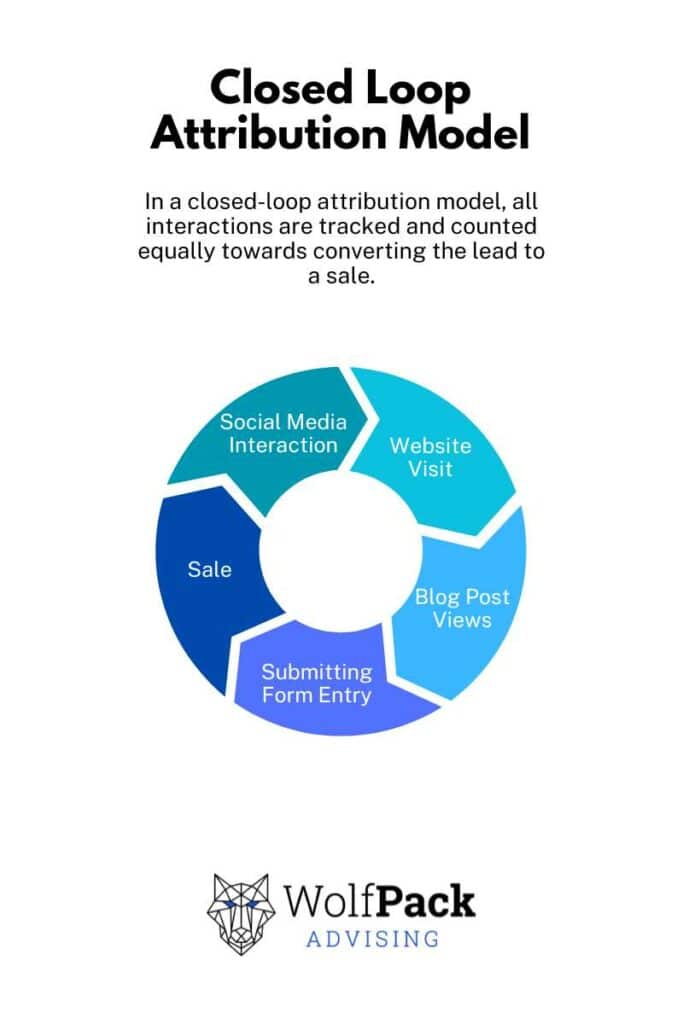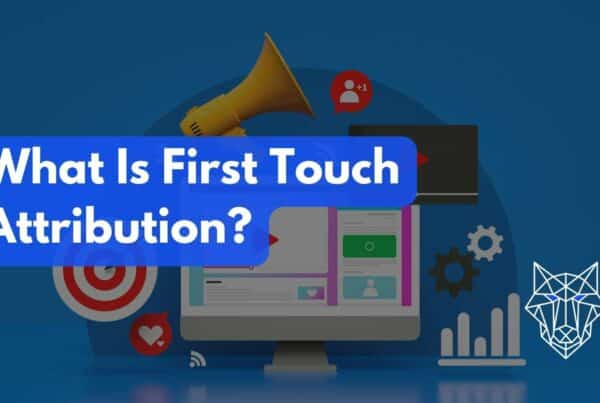Last updated on August 29th, 2023 at 10:44 am
In today’s fast-paced digital landscape, businesses rely heavily on marketing to reach their target audience and drive growth. But in the age of abundant data, how can organizations ensure that their marketing efforts are not just shots in the dark? The answer lies in closed-loop attribution – a sophisticated marketing strategy that connects the dots between marketing efforts and actual business outcomes. In this blog post, we will dive into the concept of closed-loop attribution and explore why it matters more than ever.
What is Closed Loop Attribution?
Closed loop attribution is a data-driven marketing approach that aims to measure and analyze the impact of marketing efforts on the overall business results. In simpler terms, it tracks the entire customer journey, from initial touchpoints to the final conversion or purchase, and allows marketers to understand precisely which marketing activities contribute most significantly to revenue generation.
The process of closed-loop attribution involves collecting data from various marketing channels such as social media, email campaigns, online ads, and website interactions. This data is then combined with data from the sales team, customer relationship management (CRM) systems, and other business metrics to create a comprehensive view of the customer journey.

Different Attribution Types & What’s Most Popular
When speaking on closed-loop attribution models, it’s also important to understand the other main types of attribution models and which one is the most popular type.
In the realm of marketing attribution, there are various methods to attribute credit to different marketing channels and touchpoints along the customer journey. Each attribution type provides a unique perspective on how marketing efforts contribute to conversions and sales.
Let’s explore some of the most common marketing attribution types:
- First-Touch Attribution:
First-touch attribution assigns full credit for a conversion or sale to the very first interaction a customer has with the business. It emphasizes the initial touchpoint, such as clicking on an ad or visiting a website for the first time. While this approach provides insight into the effectiveness of the top-of-the-funnel marketing efforts, it may not fully acknowledge the role of subsequent interactions that influence the customer’s decision. - Last-Touch Attribution:
Contrary to first-touch attribution, last-touch attribution attributes all credit for a conversion or sale to the final touchpoint before the customer converts. This method gives the most credit to the last marketing activity the customer engaged with, like clicking on a specific ad or link that leads to the purchase. While it may be straightforward, last-touch attribution overlooks the cumulative impact of previous touchpoints that may have nurtured the lead. - Linear Attribution:
Linear attribution distributes credit evenly across all touchpoints in the customer journey. This approach acknowledges that every interaction along the path played a role in the conversion process. While it provides a more holistic view than first or last-touch attribution, it still doesn’t consider the varying impact each touchpoint may have had on the customer’s decision.
Additional marketing attribution types to know:
- Time-Decay Attribution:
Time-decay attribution gives more credit to touchpoints that occurred closer to the conversion. It assumes that the closer the interaction is to the actual purchase, the more influential it was in the decision-making process. This model is particularly useful for understanding how customers move through the funnel and what prompted them to take the final step. - Position-Based Attribution (U-Shaped):
Position-based attribution, also known as U-shaped attribution, gives significant credit to both the first and last interactions in the customer journey, while the remaining touchpoints receive less credit. This model recognizes the value of brand awareness at the beginning and the impact of the final persuasive touchpoint in converting the lead into a customer. However, it may not fully acknowledge the contribution of middle-funnel nurturing efforts. - Custom Attribution Models:
Some businesses may develop custom attribution models tailored to their unique marketing strategies and objectives. These models can blend elements of different attribution types to create a more accurate representation of how marketing efforts impact conversions and sales. Custom models can be beneficial when standard models do not align with a company’s specific marketing and sales processes.
The Most Popular Attribution Types & Choosing An Attribution Type
The most popular attribution model among this list is the last-touch attribution model as it is commonly used in Google Analytics and Google Ads. It’s how most companies find their return on ad spend (ROAS). This is because of its ease of use, quick precedence, historical usage, and lack of integration needed between departments/teams.
It’s essential to choose the most appropriate attribution model based on your business’s goals, sales cycle, and customer journey. While closed-loop attribution provides comprehensive insights, combining it with the right attribution model allows marketers to understand the customer journey better and make data-driven decisions that drive business success. Remember, attribution is not a one-size-fits-all approach; it’s a dynamic process that evolves as businesses and marketing strategies evolve.
Why Does Closed Loop Attribution Matter?
- Accurate Measurement of Marketing ROI: One of the primary reasons closed-loop attribution matters is that it provides marketers with a clear understanding of the return on investment (ROI) for each marketing channel. By knowing which campaigns are driving actual sales and revenue, businesses can allocate their marketing budgets more effectively and optimize their strategies for maximum impact.
- Optimized Marketing Spend: Closed-loop attribution enables marketers to identify which channels and campaigns are most successful in converting leads into customers. This data-driven insight helps businesses focus their efforts on high-performing channels, thereby eliminating wasteful spending on less effective ones.
- Improved Customer Experience: Understanding the customer journey through closed-loop attribution allows businesses to tailor their marketing messages and interactions to meet the specific needs and preferences of their target audience. By delivering personalized and relevant content, businesses can enhance the overall customer experience, leading to higher customer satisfaction and loyalty.
- Data-Backed Decision Making: In the competitive business landscape, relying on gut feelings and intuition is no longer enough. Closed-loop attribution provides concrete data and insights to support marketing decisions, making the decision-making process more informed and reliable.
- Alignment Between Marketing and Sales Teams: Often, there is a gap between marketing efforts and sales outcomes. Closed-loop attribution bridges this gap by fostering collaboration between marketing and sales teams. When both teams have access to the same data and insights, they can work together to create a cohesive and streamlined customer experience.
- Continuous Optimization: Closed-loop attribution is not a one-time analysis but an ongoing process. By continuously monitoring and analyzing data, marketers can identify trends, patterns, and opportunities for improvement. This iterative approach allows for continuous optimization of marketing strategies, ensuring that they stay relevant and effective in a dynamic market.
Can You Use Closed Loop Attribution In Conjunction With Last Touch Attribution?
Closed-loop attribution and last-touch attribution are two different approaches used in marketing to understand the impact of marketing efforts on conversions and sales. They can be used in conjunction with each other or separately, depending on the business’s goals and the level of granularity needed in their analysis.
Used Together:
In some cases, businesses may use closed-loop attribution in conjunction with last-touch attribution as part of a multi-touch attribution model. Closed loop attribution, as discussed in the blog post, focuses on connecting marketing efforts to actual business outcomes and involves integrating data from various marketing channels with sales and CRM data. On the other hand, last touch attribution gives full credit for a conversion to the last marketing touchpoint before the customer converts.
By combining the two, businesses can gain a comprehensive understanding of the customer journey. Closed-loop attribution provides insights into the overall effectiveness of marketing efforts in driving sales and revenue, while last-touch attribution highlights the specific touchpoints that directly led to the conversion. This approach offers a more detailed and nuanced view of marketing performance, ensuring that both top-of-the-funnel and bottom-of-the-funnel activities are acknowledged.
Used Separately:
Alternatively, some businesses may choose to use closed-loop attribution or last-touch attribution independently, depending on their analytical needs and resources. Closed-loop attribution is especially valuable for understanding the overall impact of marketing efforts on the entire customer journey and for optimizing marketing strategies based on data-driven insights.
On the other hand, last touch attribution, while simpler, can still provide valuable information about the final touchpoints that contributed to conversions. It is relatively easier to implement and interpret compared to more complex multi-touch attribution models, making it a practical choice for certain scenarios.
Ultimately, the choice between using closed-loop attribution and last-touch attribution together or separately depends on the specific goals and complexities of the marketing strategy. For businesses with the resources and expertise to implement multi-touch attribution models, a combination of both approaches can yield the most comprehensive and insightful results. However, for others, using them separately can still provide valuable information for optimizing their marketing efforts.
How To Track Closed Loop Attribution?
Closed-loop attribution is commonly tracked through advanced marketing software and analytics systems. Here are some popular software options:
- Google Analytics 360: Google Analytics 360 is a premium version of Google Analytics that offers more advanced attribution features, including data-driven attribution and multi-channel funnels. It integrates with Google Ads and other advertising platforms, allowing businesses to track conversions and attribute them to specific marketing channels and campaigns.
- Adobe Analytics: Adobe Analytics is a robust marketing analytics solution that provides powerful attribution capabilities. It helps businesses track customer interactions across different channels and devices, enabling them to measure the impact of marketing activities on customer behavior and conversions.
- HubSpot: HubSpot is an all-in-one inbound marketing and sales platform that offers closed-loop reporting. By integrating marketing data with its CRM system, HubSpot allows businesses to track and analyze how leads generated through marketing efforts progress through the sales funnel.
It is important to remember your marketing software needs to be able to track all marketing efforts and aggregate the lead data together.
Example of Closed Loop Attribution
Here is an example of how a customer might interact with a business and how a business uses closed-loop attribution software to monitor their marketing campaign performance.
- A lead views your social media post.
- From your social media post, the lead then clicks on your profile and then navigates to your website.
- On your website, the lead clicks around your website, to different pages to learn more.
- Finally, the lead submits a form on your website that submits their data to your sales team.
- The lead’s data is sent to the sales team to then convert into a customer.
Your software should be able to track that information all in one place to show how your social media post played a role in the sale. Additionally, the closed-loop attribution would show which pages on the website also helped push the lead to submit their information. Finally, the last attribution would be through how the sales team was able to win the customer.
Final Thoughts
In conclusion, closed-loop attribution is a powerful marketing tool that empowers businesses with data-driven insights, enabling them to make informed decisions, allocate resources efficiently, and ultimately drive growth and success. While not for everyone, closed-loop attribution can help businesses give a holistic view of their marketing efforts and how it impacts a customer’s sales journey.
Ready to take your marketing to the next level? Get a proposal from the Alpha in Digital Marketing.





